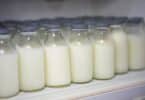While it has long been known that breastfeeding provides infants with immunity protection, science couldn’t really give a definitive answer on how the “passive immunity” process works. A University of California Riverside study may provide some answers. Yet it may also spark more questions. For example, is it possible to vaccinate a baby without actually and actively vaccinating the baby themselves? And if so, when should this practice be exercised?
Conducted on mice, the study revealed that immune cells in a mother’s milk cross through the wall of an infant’s intestine and then enter the thymus, and immune organ that “educates” the baby’s developing cells, which then duplicate the mother’s immune cells. Essentially, the baby’s immune system is being taught to defend against the same sorts of viruses and bacteria that the mother has been exposed to.
“It’s another way moms provide immune information to their babies,” said Ameae Walker, professor of biomedical sciences in the UC Riverside School of Medicine, and leader of the study. “It’s as though the mother is saying, ‘Look what I have seen in the environment that you need to be immune to as well.’ The replicas – the copies of the maternal immune cells that the baby makes – will provide immunity to the baby for life.”
Researchers believe this may translate into vaccines as well. For example, the mother may be able to provide immunity to certain conditions for her baby if she is vaccinated prior to pregnancy (which would likely ensure she had the antibodies in her breast milk when the baby was born).
“While our work has used mouse models because we can study the process in detail this way, we do know that milk cells cross into human babies as well,” Walker said. “We hope that, by vaccinating the mother, who will eventually nurse the baby, we will improve infant immunity . . . It’s like vaccinating the baby without actually vaccinating the baby.”
Of course, using this concept in every situation might not be optimal. For example, would it be enough to expect a mother to pass along an immunity to measles to their baby, just because they have received the MMR vaccine? Probably not. Instead, the researchers hope to use the information to help infants develop immunity to conditions they cannot be vaccinated for, due to severe risk. One prime example is tuberculosis, which is a serious problem in some parts of the world.
“Some vaccines are not safe to give a newborn and others just don’t work very well in newborns . . . If we can, instead, vaccinate mom or boost her vaccination shortly before she becomes pregnant, transferred immune cells during breastfeeding will ensure that the baby is protected early on,” Walker said. “In some instances, our work has shown that immunity against TB is far more effective if acquired through the milk than if acquired through direct vaccination of the baby. Of course, clinical trials will need to be conducted to test whether this is the case in humans.”
Interestingly enough, though, this concept may not be a new one. According to Walker, wet nurses and “community” breastfeeding may have greatly contributed to the survival of royal babies and other infants who may have been at risk for common illness. She explained further by saying the following:
“Wet nurses were usually from a lower social echelon and were likely exposed to more infectious agents. They had to have very robust immune systems to survive . . . What the research is telling us is that a baby would likely gain from nursing by multiple women with different immune backgrounds. Not too long ago, in most cultures, if a baby cried a woman would pick it up and nurse it; most women were lactating. Now, socially, we would think that rather peculiar – to nurse someone else’s baby. But is the change in how society thinks about this issue the best for the baby’s health?”







